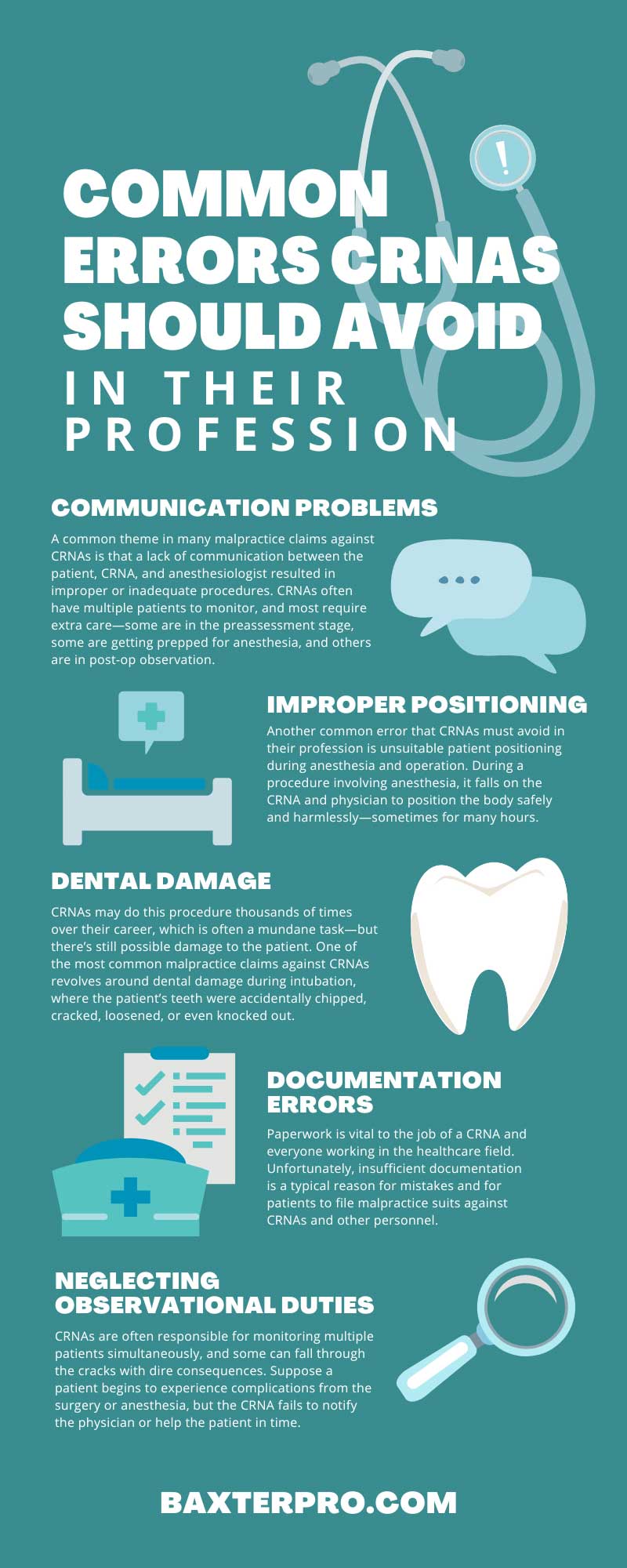Certified Registered Nurse Anesthetists (CRNAs) fulfill an essential role in healthcare, but with that responsibility comes risks and consequences when mistakes happen. In our guide, we’ll go over some of the most common errors from CRNAs in their profession that cause malpractice claims against them.
We’ll explain how these errors happen and offer some strategies on how CRNAs can avoid risk.
Do CRNAs Get Sued Often?
Before we get into the errors that may cause malpractice claims against CRNAs, we have to ask: do they get sued that often?
Yes. It isn’t uncommon to be named in a lawsuit as a nurse anesthetist.
CRNAs are not shielded from litigation and are the targets of malpractice claims if the patient determines an individual mistake from the CRNA caused their pain and suffering. CRNAs are the most frequently sued nursing specialty. The number of CRNAs as defendants has steadily grown over the years, and experts forecast the litigation to continue as the number of malpractice lawsuits grows.
Common CRNA Mistakes That Cause Malpractice Claims
While CRNAs are not always the focus of malpractice litigation, some individual mistakes can get traced back to errors from CRNAs. In cases of these mistakes, CRNAs can become the target of litigation and held responsible for a patient’s suffering or even expiration. With that in mind, here are some common CRNA mistakes to watch out for.
Communication Problems
A common theme in many malpractice claims against CRNAs is that a lack of communication between the patient, CRNA, and anesthesiologist resulted in improper or inadequate procedures. CRNAs often have multiple patients to monitor, and most require extra care—some are in the preassessment stage, some are getting prepped for anesthesia, and others are in post-op observation.
With so many patients to juggle, it’s easy for things to get missed, lost in translation, or forgotten entirely. A common example of a communication problem is when a CRNA or anesthesiologist conducts a pre-anesthetic evaluation but doesn’t discuss findings with the other parties, resulting in a faulty anesthesia plan that harms the patient.
Improper Positioning
Another common error that CRNAs must avoid in their profession is unsuitable patient positioning during anesthesia and operation. During a procedure involving anesthesia, it falls on the CRNA and physician to position the body safely and harmlessly—sometimes for many hours.
Anyone who’s taken a nap on a couch understands that if your positioning is off for too long, you can wake up with a sleepy arm or leg. In procedures, awkward positioning can cause more lasting nerve damage and even loss of motor function in some cases.
Dental Damage
One of the primary duties of many CRNAs is to intubate patients. Intubation involves inserting a tube into a patient’s throat to ensure an open airway for breathing throughout the operation.
CRNAs may do this procedure thousands of times over their career, which is often a mundane task—but there’s still possible damage to the patient. One of the most common malpractice claims against CRNAs revolves around dental damage during intubation, where the patient’s teeth were accidentally chipped, cracked, loosened, or even knocked out.
Insufficient Assessment & Evaluation
CRNAs are also often responsible for performing the anesthesia preassessment, evaluation, and obtaining the patient’s informed consent. During these duties, it’s not uncommon for mistakes to get made, like a part of the patient’s history gets missed or the patient feels they weren’t fully informed before the procedure.
It’s the patient’s right to have the procedure explained to them, along with who will be performing it and their qualifications. It’s also the patient’s right to ask that only an anesthesiologist perform specific duties instead of a CRNA. There have been malpractice claims where patients felt they weren’t duly informed of the procedure or that they could request an anesthesiologist to perform certain tasks—resulting in the CRNA getting targeted for omitting important information.
Documentation Errors
Paperwork is vital to the job of a CRNA and everyone working in the healthcare field. Unfortunately, insufficient documentation is a typical reason for mistakes and for patients to file malpractice suits against CRNAs and other personnel.
If a CRNA fails to sufficiently update a patient’s documentation—like a patient’s history, physician’s orders, or medication prescription—it can have dire consequences later. Without all information, anesthesiologists and other physicians might administer harmful medication to the patient or perform dangerous procedures, making the CRNA liable for not updating the documentation correctly.
Neglecting Observational Duties
Much of a CRNA’s job is monitoring patients before and after administering anesthesia. Often, this observation is only prudent, and the patient recuperates painlessly from the procedure and anesthesia.
But, as we mentioned, CRNAs are often responsible for monitoring multiple patients simultaneously, and some can fall through the cracks with dire consequences. Suppose a patient begins to experience complications from the surgery or anesthesia, but the CRNA fails to notify the physician or help the patient in time. In that case, it can lead to more severe health damage or even death. In those cases, an investigation could find the CRNA responsible as their duty was the observation of the patient.
Strategies for Decreasing Risk as a CRNA
What can CRNAs do to decrease these risks and errors on the job? CRNAs are only human, so mistakes are bound to happen, but there are ways to help avoid and mitigate these risks as much as possible.
Obtain Informed Consent
Informed consent is at the heart of many malpractice claims against CRNAs—patients feel they weren’t duly informed of the dangers or the qualifications of personnel performing them. So, informed consent is an essential part of the preassessment process for CRNAs.
Ensure that the patient fully understands the anesthesia plan and knows their rights as a patient before consenting.
Have Malpractice Insurance
As we’ve said, mistakes happen—but when they do, they don’t have to cost a CRNA their career or financial security. That’s why CRNA liability insurance is essential for every CRNA.
Without proper malpractice insurance, CRNAs can have their entire financial future and career turned upside down because of one mistake or perceived error.
Avoid Burnout
Burnout is among the most common problems for nurses in healthcare, even CRNAs. Medical professionals can experience burnout from working long hours under stressful conditions and an imbalanced personal and work life.
When CRNAs experience burnout, they’re more likely to make mistakes, so mental health and wellness are also essential for CRNAs. CRNAs should do their best to maintain a healthy personal life outside of work, get plenty of rest, or even seek mental health counseling if they think it could improve their mental state.
If you have any further questions about malpractice insurance, don’t hesitate to contact our expert staff at Baxter & Associates. We can help you get the protection you need.








